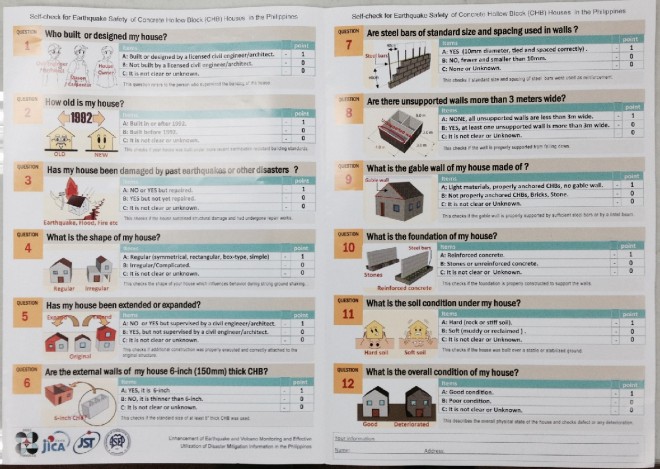Phivolcs draws up do-it-yourself test for house safety
MANILA, Philippines — Just how safe is your house?
State seismologists have developed a 12-point self-check tool to determine if houses made of concrete hollow blocks would be able to withstand a major earthquake.
The Philippine Institute of Volcanology and Seismology launched on Wednesday the self-assessment test that would enable homeowners to rate the safety of their own houses based on their history and structural details.
In a briefing at the agency’s headquarters in Quezon City, Phivolcs Director Renato Solidum said he hoped the new tool would be disseminated to local governments from the provincial down to the barangay or village level.
Article continues after this advertisementThe self-check tool consists of 12 questions about the house, including who built or designed it, how old it is, its shape, the thickness of the walls, its foundation, the condition of the soil underneath, and its overall condition.
Article continues after this advertisementPoints are assigned based on the level of risk, and a house with 11 to 12 points, the maximum score, is regarded “safe for now, [but] please consult experts for confirmation.”
Houses with a score of 8-10 points will “require strengthening,” while those with 0 to 7 points are “disturbing.”
The self-check tool recommends that whether the score is 0 or 12, the homeowner must consult professionals about the safety of the house, and whether it complies with standards set by the National Building Code.
Once a homeowner discovers that his house is vulnerable, the next step will be to consult local government engineers who may be able to recommend affordable ways of strengthening or retrofitting the house, Solidum said.
Ronaldo Ison of the Association of Structural Engineers of the Philippines (ASEP), one of the partners of the project, said the organization was holding workshops throughout the country to teach the public cheap and simple ways to retrofit their homes.
The self-check project is a collaboration among Phivolcs, the Japan International Cooperation Agency,the Japan Science and Technology Agency, and ASEP.
Solidum said a great majority of houses in the Philippines were made with concrete hollow blocks, and were “non-engineered,” as most people hire only carpenters and masons to build a house, and not engineers because of the cost.
Most of these houses do not comply with the specifications set by the building code.
In fact, in February 2011, scientists from Japan and the Philippines tested two full-scale models of concrete hollow block houses, one of which was constructed following the building code standards while the other was not.
The first model, after being subjected to a simulated magnitude 6.9 quake, withstood the tremors with only minor damage, but the second model had its gable collapsing. The gable is the triangular portion of the wall between the sloping edges of the roof.
Solidum said Phivolcs would collaborate with the Department of the Interior and Local Government and other agencies for the dissemination of the 12-point self-check tool to the general public.
“The next question is what is the solution (to unsafe houses)? The solution might not be the same for everyone,” which is why, he said, it is important to consult building experts and professionals.
RELATED STORIES
What if 7.6 quake hit Metro Manila?
